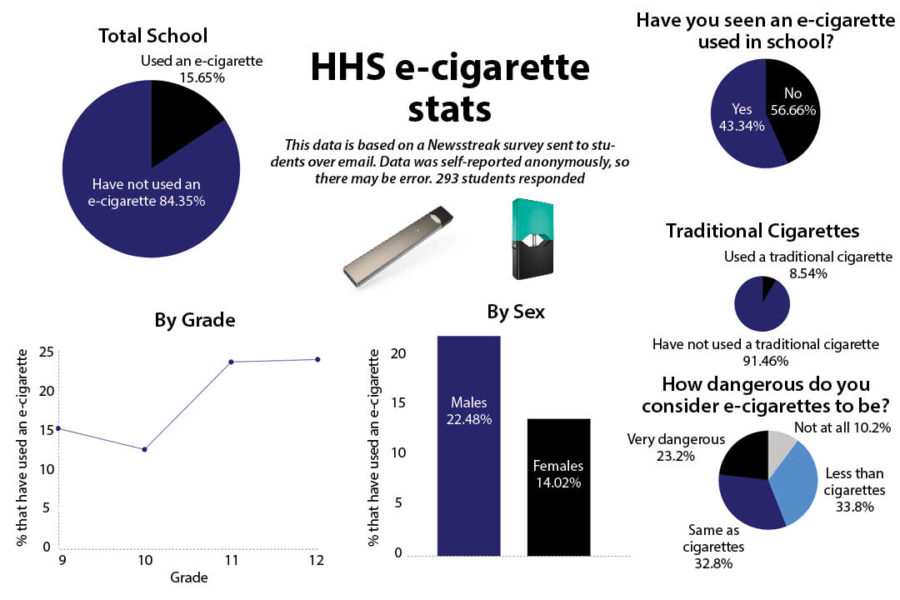Chapter 1: Students fight with peer pressure and addiction
October 9, 2018
It was about halfway through last school year when John Williams* first saw Juul use skyrocket. His use of the USB-shaped electronic cigarette was social at first.
“It was one of those things that one of my friends had. I just wanted to try it at first,” Williams said. “After a while, I decided to get myself one.”
For Williams, it wasn’t long before he was fully addicted. He has since quit and considers Juuling dangerous.
“After a while, I realized it was really hurting my ability to participate in athletics, so I had to stop,” Williams said. “I felt bad because I knew it was hurting my body and it wasn’t good for me. Even if it did feel good at the time, always after I’d feel terrible. It wasn’t worth it.”
Similarly to Williams, Robert Davis* first used a Juul in a social setting.
“[I started Juuling] because it’s a way to be cool,” Davis said. “I only Juul if my friends are around… I don’t really enjoy it for the feeling, I just like the social aspect.”
Unlike Williams, Davis would not consider himself addicted. However, nicotine has still brought him unpleasant experiences.
I know it’s really cliché, but the most popular kids often did it.
— Robert Davis
“Once I was trying to ghost, which is a trick you can do, and I nic-ed out, which means you feel really sick and nauseous to the head,” Davis said. “It’s not a permanent thing, but it made me stop for a couple days because it grossed me out.”
When it comes to quitting for good though, Davis is a little less sure.
“I’m probably going to quit after college. As an adult, I don’t need to do that kind of stuff,” Davis said. “Again, it’s a social thing for me, so if it ever phases out, I’m not going to be Juuling.”
Even though Davis feels this way, nicotine has consistently been ranked among one of the most addictive drugs. According to the Centers for Disease Control and Prevention (CDC), almost 90% of nicotine addicts first tried smoking by age 18.
In the past few years, Juul and other e-cigarette use among high school students has continued an upward trend. According to CDC data collected in 2017, 11.7% of high school students had used an e-cigarette in the last 30 days, up from just 1.5% in 2011.
Based on Newsstreak survey data, about 15% of the school had tried an e-cigarette. This percentage was significantly higher for juniors and seniors than freshman and sophomores. Males were also more likely to have used an e-cigarette than females. Juul was by far the most commonly used e-cigarette at HHS.
Juul has been criticized by the Food and Drug Administration for failing to keep products away from minors and is investigating its marketing practices.
Davis sees Juul’s rise as connected to social status.
“[It took off] because it was the cool kids that did it,” Davis said. “I know it’s really cliché, but the most popular kids often did it.”
Tied to that, Davis thinks that it also has to do with the platitude of teenage rebellion.
“I don’t really base my self-identity off disrespecting authority, but I know some kids get a rush by doing it in places where they shouldn’t be,” Davis said.
Williams also pointed out that a lot of money can be made selling Juul products within the school, something he did himself. Based on the Newsstreak survey, most e-cigarette users at HHS bought products from other students.
Juul user James Johnson* regrets starting to Juul because of its financial burden. A Juul starter kit is $50. Each pod, equivalent in nicotine content to a pack of cigarettes, retails for $4.
“I wouldn’t [start Juuling] if I had the choice just because of economics,” Johnson said. “Other than that I don’t really care about all the statistics and the Daily Mail ads you see on Snapchat.”
Although e-cigarettes expose users to less harmful chemicals than traditional cigarettes, nicotine is still dangerous. The CDC reports that nicotine can harm parts of the brain that control attention, learning, mood, and impulse control. Another issue is e-cigarette users hooked on nicotine transferring to traditional cigarettes, which contain hundreds of additional harmful chemicals.
However, Davis doesn’t see this as an issue for himself.
“Personally, I’m never going to smoke a cigarette, just because of the millions and millions of data points that prove there’s not just a correlation but a strong causation between cigarettes and lung cancer,” Davis said. “In the generation before us, people didn’t really know the negative effects of smoking. If Juuling turns out to cause health [problems], it could be similar. The difference is [that] we’re a lot more advanced now when it comes to science.”
In Davis’s opinion, Juuling may even act as a form of catharsis.
“If you Juul, I think there are a lot worse things you could be doing,” Davis said. “I don’t feel the inclination to do strong drugs because I Juul.”
However, this assumption is probably wrong. According to the CDC, nicotine use in adolescence may actually increase the risk for future addiction to other drugs.
For Davis as well as Johnson, the thing that will make them most likely to quit is not the current scientific evidence but simple peer pressure.
“Once the Juul phase stops, I’ll quit,” Johnson said.
*A pseudonym has been used to protect the privacy of this individual.
